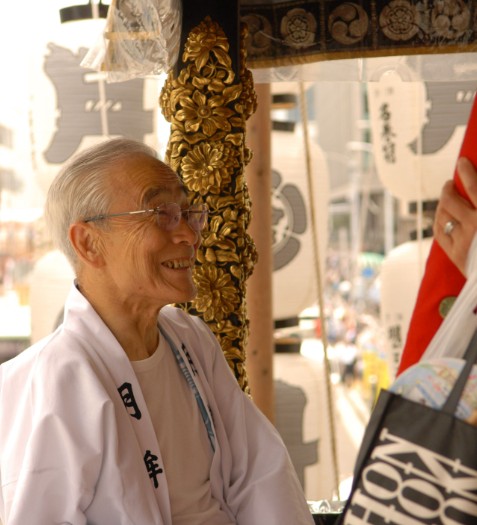For example, there are at least six associations that carry the three portable mikoshi shrines back and forth between Yasaka Shrine and central Kyoto on July 17 and July 24; there are 34 associations for each of the 34 yamaboko floats; there are associations of traditional dancers, musicians, and geiko (geisha and apprentice maiko) for the Hanagasa Junko; and more!
There’s a surprisingly small amount of coordination between the different associations. Instead, each undertakes their role with the utmost dedication, resulting in the gargantuan, dazzling Gion Matsuri that we enjoy. The festival’s 1150+ years of illustrious history represents a triumph of community collaboration difficult to match anywhere on the planet.

Each yamaboko float has a neighborhood association, called chōnai. What does that matter? The chōnai are essential: each one is in charge of its own float and its treasures.
Each chōnai consists of half a city block, with the block cut diagonally across the middle like a sandwich: each half comprises a chōnai. Traditionally a Gion Festival chōnai sponsored, funded, maintained and celebrated its own yamaboko float. The rise and fall of the Gion Festival yamaboko and their treasures mirrored the fluctuations in fortunes of residents of these Gion Festival chōnai.
Historically, Gion Festival chōnai members were families and companies who lived and worked in the neighborhood. This was a privilege: prospective residents had to apply, and meet stringent requirements.
Until Japan’s economic bubble burst, this part of Kyoto was the epicenter of the kimono world. When I lived there in the early 1990s, the Gion Festival neighborhood still boasted large numbers of kimono-related merchants: wholesalers in kimono, silk, dyers and the like.
The collapse of the kimono industry in post-bubble Japan transformed the Gion Festival chōnai. Historical homes and companies have given way to apartment buildings, seasonal residents, and modern businesses like offices, restaurants and convenience stores.
With major growth in non-chōnai support of the Gion Festival–World Heritage status, National Treasure and Important Cultural Property status, tourism, related government subsidies–the Gion Festival’s foundation is morphing. More than ever, the festival patrons are stalwart champions of its traditions.
For example, traditionally there’s a Gion Festival sub-festival called the Byōbu Matsuri (Folding-Screen Festival). Even now resident families and companies graciously open their doors and windows to display priceless folding screens, suits of armor, kimono and other family heirlooms.
More than a million people visit the Gion Festival each year. That means that visitors like you and me (though mostly Japanese) far outnumber the Gion Festival chōnai members. How can this possibly be sustainable?
I’ve reflected a lot on this. As festival visitors, how can we respond in kind to the festival patrons’ hospitality and generosity?
It’s a surprisingly simple shift in perception: We visitors recognize that we are part of the community. And what do community members do? Support one another.
It may be only for an hour, an evening, or a day. But while we’re at the festival, we can show some appreciation for the Gion Festival chōnai and other community members. It can be a smile, a thank you, or buying a souvenir of a favorite float. After all, these people graciously volunteer to keep the Gion Festival going for us to enjoy. And our appreciation fuels their efforts.